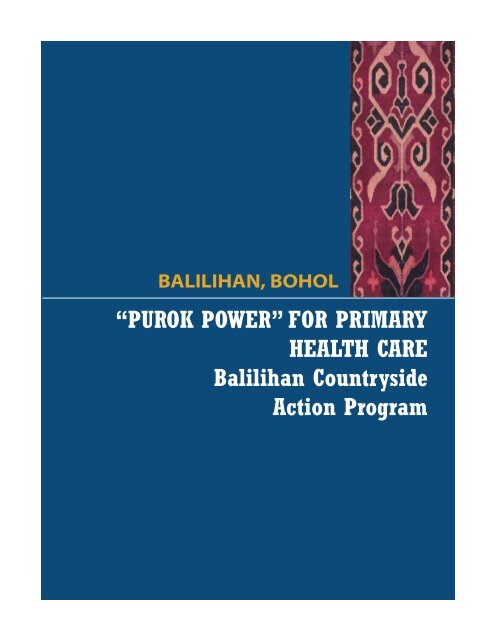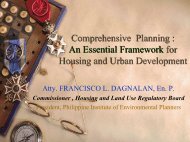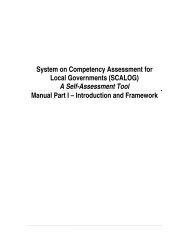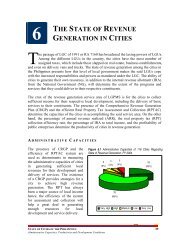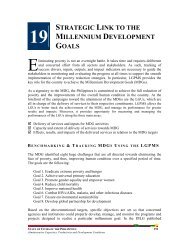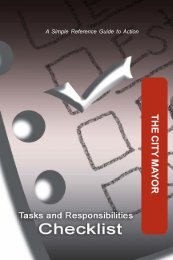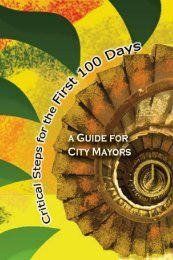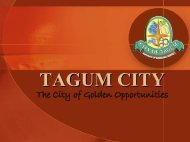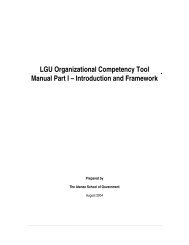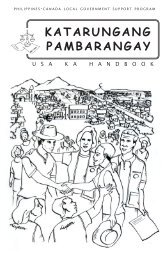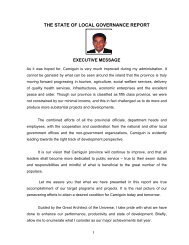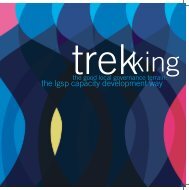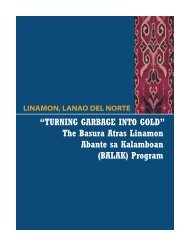You also want an ePaper? Increase the reach of your titles
YUMPU automatically turns print PDFs into web optimized ePapers that Google loves.
BALILIHAN, BOHOL<br />
“PUROK POWER” FOR PRIMARY<br />
HEALTH CARE<br />
<strong>Balilihan</strong> Countryside<br />
Action Program
“PUROK POWER” FOR PRIMARY HEALTH CARE<br />
<strong>Balilihan</strong> Countryside Action Program<br />
Copyright © <strong>2004</strong> Philippines-Canada Local Government Support Program<br />
(LGSP)<br />
The Philippines-Canada Local Government Support Program encourages the<br />
use, translation, adaptation and copying of this material for non-commercial<br />
use, with appropriate credit given to LGSP.<br />
Although reasonable care has been taken in the preparation of this book,<br />
neither the publisher and/or contributor and/or editor can accept any liability<br />
for any consequence arising from the use thereof or from any information<br />
contained herein.<br />
Printed and bound in Manila, Philippines<br />
Published by:<br />
Philippines-Canada Local Government Support Program<br />
Unit 1507 Jollibee Plaza<br />
Emerald Ave., Pasig City<br />
1600 Philippines<br />
Tel. Nos. (632) 637-3511 to 13<br />
www.lgsp.org.ph<br />
This project was undertaken with the financial support of the Government of<br />
Canada provided through the Canadian International Development Agency<br />
(CIDA).
CONTENTS<br />
Summary<br />
About <strong>Balilihan</strong>, Bohol’s Countryside Action Program (CAP)<br />
Project History<br />
Project Description<br />
Project Results<br />
Replicating Countryside Action Program (CAP)<br />
Key Implementation Steps<br />
Reference Matrix On Replicating Countryside Action Program<br />
Lessons And Insights In Replicating The Project<br />
Annexes<br />
1<br />
3<br />
5<br />
5<br />
7<br />
8<br />
8<br />
<strong>10</strong><br />
11<br />
13
Summary<br />
Under the local governance system, puroks are sub-units of the barangay, which<br />
is the basic political unit of the government. Traditionally, however, puroks are<br />
no more than loose geographical groupings of households within the barangays,<br />
with little political or social function.<br />
In <strong>Balilihan</strong>, Bohol, the lowly “purok” has been transformed into a powerful tool for<br />
community mobilization and action, particularly<br />
in the area of primary health care.<br />
In 1998, then newly-elected Mayor Edgar Chatto<br />
saw the potential of harnessing puroks as a main<br />
force for the delivery of primary health care<br />
services. Mayor Chatto launched the <strong>Balilihan</strong><br />
Countryside Action Program (CAP) with the aim<br />
of mobilizing and organizing local government,<br />
rural health units, health personnel and local<br />
residents towards the more effective delivery of<br />
basic services.<br />
“PUROK POWER”<br />
FOR PRIMARY<br />
HEALTH CARE<br />
<strong>Balilihan</strong> Countryside<br />
Action Program<br />
<strong>Balilihan</strong>, Bohol<br />
The program had two core strategies:<br />
1) capacity building at the municipal and barangay levels through training, to strengthen<br />
such structures as the Municipal Development Council, the Municipal Council, the<br />
Barangay Development Council, and<br />
2) mobilizing and organizing households into puroks or health zones that would then<br />
identify problems and needs, formulate actions and undertake programs at the purok<br />
level.<br />
Today, a total of 186 puroks have been established in the 31 barangays of <strong>Balilihan</strong>, with<br />
1,302 sectoral volunteers organized and acting as a semi-autonomous extensions of the<br />
local government. Some 50% of the population actively participates in purok activities,<br />
including livelihood projects, health care services, feeding programs, vegetable and<br />
herbal gardens. Various infrastructure projects have been undertaken, accessed by the<br />
puroks themselves from the national line agencies through the support of the municipal<br />
government. Most importantly, <strong>Balilihan</strong> has been able to meet 95% of its health and<br />
nutrition targets.<br />
In 1997, the municipal government of <strong>Balilihan</strong> approved an ordinance institutionalizing<br />
the purok system in every barangay, thus ensuring its sustainability.<br />
5
“Making Crime Prevention Everybody’s Business”<br />
<strong>Balilihan</strong>’s success has not gone unnoticed. In 1994, <strong>Balilihan</strong> won the Health and<br />
Management Information System (HAMIS) Gold Medal awarded by the Department of<br />
Health. The German Agency for Technical Cooperation (GTZ) recognized <strong>Balilihan</strong> as having<br />
the most Outstanding Health Care Management Program in.<br />
6
Bantay sa Kahusay Ug Kalinaw (BKK): Oroquieta City, Misamis Occidental<br />
ABOUT THE PROJECT<br />
Project History: Turning Failure into Success<br />
The idea of mobilizing puroks was<br />
not new to <strong>Balilihan</strong>. The Rural Purok<br />
Initiative, a strategy of the Department<br />
of Health for rural health care was first<br />
launched in 1983. The initiative did<br />
not take off, however, mainly due to the<br />
compartmentalized view and system for<br />
delivering health care at the time and<br />
the lack of support from the national and<br />
local government. With the devolution<br />
of health services, the time became ripe<br />
for reviving the project.<br />
The Purok system under the Baliliha’s CAP has been attracting<br />
When Mayor Edgar Chatto assumed many visitors (e.g. healthworkers) for possible replication in their<br />
office in 1988, he built on the beginnings<br />
respective areas/LGUs<br />
of the Rural Purok Initiative and drew in<br />
other sectors to carry out a more holistic mode to development; he also gave it a new name -<br />
the Countryside Action Program. One of the components of the Countryside Action program<br />
was the Primary Health Care through Purok.<br />
The primary health care component had 4 objectives:<br />
1. Raise health consciousness among residents<br />
2. Organize teams of purok-level volunteers that can assist the municipal health workers in<br />
maximizing health services at the purok level<br />
3. Encourage the design and implementation of purok-level livelihood projects<br />
4. Mobilize human and material resources for networking with national agencies and NGOs<br />
for the implementation of community-based health programs<br />
Project Description: Power at the Purok Level<br />
Capacity Building from the municipal to barangay level<br />
The CAP framework departed from the usual top-down approach. The Mayor begun the<br />
program by launching a series of capability-building programs. Among the first trained<br />
were the municipal government officials and employees, the members of the Municipal<br />
Development Council and local legislators. The Association of Barangay Chairs and the<br />
Barangay Development Councils as well as other barangay officials also held their own<br />
seminars on barangay administration, planning and project management.<br />
7
“Making Crime Prevention Everybody’s Business”<br />
Residents also participated in training focused on sectoral concerns and technology<br />
transfer.<br />
Armed with new skills and attitudes, the municipal and barangay personnel were ready<br />
to engage the municipality as partners in development. CAP was launched with its purok<br />
system, giving spirit to empowerment through community organizing, mobilization and<br />
human resource development.<br />
Setting up the Purok Kiosks as Activity Centers<br />
The target population of CAP was the 14, 527 residents in the 31 barangays of <strong>Balilihan</strong>.<br />
These people were mostly marginal farmers of rice, corn and other staples. Each of the 31<br />
barangays was divided into six (6) puroks composed of <strong>10</strong>-25 households, resulting in a total<br />
of 186 puroks of the entire municipality.<br />
The main feature of the program that mobilized the community to participate was the<br />
construction of cluster houses or Kiosks made up of indigenous materials. The Kiosk has<br />
the features of a typical home and served as model for the members. Each Kiosk had the<br />
following: 1) Meeting / teaching area; 2) Kitchen; 3) Water sealed toilet; 4) Seed house;<br />
5) Compost pit / pile; 6) Herbal garden; and 7) Vegetable garden.<br />
Constructing the kiosks in every purok became the starting point for the mobilization of the<br />
community. With the kiosks constructed, they served as community centers for the conduct<br />
of meetings and health activities such as immunization drives, operation Timbang (weighing<br />
children to check for malnutrition), mass feeding, first aid treatment and training. These health<br />
activities and the presence of a structure built by their own hands, in turn made it easier for<br />
the community to move beyond health concerns to other community problems, such as<br />
livelihood and income generation and cooperative formation. The kiosks made it easier for<br />
people to congregate, and encouraged discussions on identifying problems and needs of the<br />
community and how best to address them.<br />
Each activity center or Kiosk has installed a system whereby residents take part in monitoring<br />
their health conditions and addressing their conditions through problem-solving activities<br />
with the purok leaders. Community members of each purok have set up systems for managing<br />
and implementing activities. Among the systems put in place:<br />
• Complete record of meetings<br />
• Health data boards<br />
• Household profiles<br />
• Organizational charts<br />
Purok leaders also coordinate with the Barangay and municipal health workers for health<br />
campaigns, and with the barangay and municipal government for other activities. Puroks also<br />
8
Bantay sa Kahusay Ug Kalinaw (BKK): Oroquieta City, Misamis Occidental<br />
network with national line agencies<br />
for specific projects identified by the<br />
puroks.<br />
Project Results: A Kiosk in Every<br />
Purok, Power in Every Community<br />
1. Meeting Health and Livelihood<br />
Needs<br />
Today, each of the 186 puroks has<br />
initiated an income-generating activity<br />
for its members. In addition, puroks Barangay officials outside Bohol Province in a visit to one of the<br />
also undertake other projects, such as<br />
Kiosks under <strong>Balilihan</strong>’s CAP<br />
vegetable and herbal gardens, compost<br />
pits, seedhouses, water-sealed toilets. As a result of the livelihood projects, a 50% increase<br />
in agricultural production was noted after 7 years of implementation.<br />
This enabled the community to meet 95% of its health and nutrition targets. Various<br />
infrastructure projects were undertaken by provincial and national government agencies.<br />
2. Creating a New Social Institution<br />
With its established puroks and currently 1,302 sectoral volunteers, the puroks now act<br />
as semi-autonomous extensions of the government. With these purok-level organizations,<br />
nearly 1 out of every six adult <strong>Balilihan</strong>hon is a sectoral volunteer. Each purok has an incomegenerating<br />
project to complement the municipal government and other agencies budgets.<br />
The Purok, then, has become a new social institution. During local elections, a candidate’s<br />
performance in his/her respective purok became an important criterion for voters. It also<br />
enhanced socialization because each Kiosk became a social hall.<br />
In the <strong>Balilihan</strong> country action program, what was initially an attempt to provide basic health<br />
services in the community itself, became a means to support and organize several community<br />
goals:<br />
• Making natural medicines available (through herbal gardens)<br />
• Better general hygiene thereby preventing and reducing the prevalence of disease<br />
• Livelihood activities so that families can increase their income and meet their basic<br />
needs<br />
• More productive and sustainable agricultural practices<br />
• Specific mechanisms to ensure peace and order in the community<br />
• Better waste management through composting initiatives<br />
9
“Making Crime Prevention Everybody’s Business”<br />
REPLICATING THE PROJECT<br />
Due to its success, <strong>Balilihan</strong>’s purok system has been replicated at the provincial level<br />
when Mayor Chatto was elected vice-governor of Bohol. It is also being replicated by other<br />
municipalities in and outside the province.<br />
Key Implementation Steps<br />
The following are the key implementation steps identified in implementing a similar<br />
project.<br />
1. Conceptualize, Get LGU approval<br />
Create a Management Team that would develop a project proposal and push for the issuance<br />
of an executive order or SB Resolution for the implementation of the project.<br />
2. Capacity Building<br />
Develop a capacity building program, in consultation with key sectors in the municipality/<br />
city and barangay and municipal/city officials.<br />
Among the training/capacity building that needs to be included in the program are:<br />
Table 1. Municipal and Barangay Training<br />
Municipal Level<br />
• Reorientation on MDC functions, duties and<br />
responsibilities<br />
• Human resource development<br />
• Effective local legislation<br />
• Integrated evaluation and planning<br />
Purok/Barangay Level<br />
• Organizing of purok health zones or districts<br />
• ABC strengthening<br />
• Barangay administration (systems and<br />
procedures)<br />
• Reorganization of BDCs<br />
• Training for barangay sectoral committees<br />
(technology transfer for agriculture, health,<br />
environmental protection, infrastructure,<br />
education, livelihood)<br />
• Project planning and evaluation<br />
• Leadership training<br />
• Primary health care<br />
<strong>10</strong>
Bantay sa Kahusay Ug Kalinaw (BKK): Oroquieta City, Misamis Occidental<br />
3. Cluster barangays as district/ health<br />
zones, assign district/health center<br />
per zone<br />
Begin the process of organizing<br />
barangays into health zones, as well<br />
as organizing puroks within each<br />
barangay.<br />
4. Construct Purok Kiosks as a first<br />
step to mobilizing community<br />
participation<br />
Mobilize the community to participate<br />
in the start-up activity of Building a<br />
Kiosk in each Purok. This includes<br />
organizing the community around the<br />
following activities:<br />
National line agencies like the Dept. of Education utilizing the<br />
kiosk in delivering services like non-formal education, illiteracy<br />
eradication, sanitation, etc.<br />
• identifying strategic sites for the purok kiosk<br />
• acquiring the lot (through donation or other means)<br />
• kiosk construction<br />
5. Mobilize and sustain community participation and project ownership<br />
This includes holding regular meetings, electing purok leaders, holding regular capacity<br />
building seminars, identifying health activities and other projects that the community would<br />
like to pursue<br />
6. Establish monitoring and evaluation system<br />
Establish as system for monitoring and evaluation progress of the purok through annual<br />
purok and barangay evaluations.<br />
11
“Making Crime Prevention Everybody’s Business”<br />
Implementation Step Timeframe Budget*/Resources<br />
Needed<br />
1. Conceptualize, get LGU approval/Creation of the<br />
Program in the LGU<br />
1.1 Project Proposal/Program Outline<br />
1.2 EO Order/SB Resolution<br />
1.3 Creation of a Management team<br />
2. Capacity building<br />
Town level<br />
2.1 Strengthening of the MDC for strong inter-agency<br />
cooperation(seminar/training workshop)<br />
2.2 Human Resource Devt Training<br />
2.3 Effective local legislation (training for developed<br />
responsive legislation)<br />
2.4 Integrated evaluation and planning<br />
District/health zone level<br />
3. Cluster barangays as district/health zones for<br />
convenient delivery of services and coordination<br />
amongst units<br />
Assign district/ health center per zone<br />
1 month<br />
1 day<br />
1-3 days<br />
1-3 days<br />
3 days<br />
2 days<br />
1 day<br />
1 week<br />
15,000<br />
25,000<br />
45-47,000<br />
5,000<br />
60,000-70,000<br />
Barangay level<br />
- Strengthening of the ABC to enhance barangay linkages<br />
- Barangay Administration Training<br />
- Organization of Secretaries, Treasurers Federation<br />
- Establishment of Barangay offices<br />
- Reorganization of Barangay Development Council<br />
- Training of Barangay sectoral committees<br />
Purok level<br />
- Purok Chairmen,Secretaries, Treasurers & Barangay<br />
Health Workers Leadership Training<br />
- Purok Health Care Workers<br />
- Training on Primary Health Care<br />
- Training for sectoral committees<br />
4.Construct Purok kiosks or Activity Centers<br />
5. Mobilize and sustain community participation and<br />
project ownership<br />
1 month<br />
1-3 days<br />
3 days<br />
1 month<br />
1 week<br />
3 days per sector<br />
(total of 21 days)<br />
3-5 days<br />
3 days<br />
1 month<br />
(identification to<br />
construction)<br />
Once a month<br />
60,000- 65,000<br />
<strong>10</strong>0,000<br />
50,000- 60,000<br />
(bayanihan)<br />
6. Establish monitoring and evaluation system Through<br />
annual purok<br />
an Barangay<br />
evaluations<br />
*Note:Budget/funds are sourced from the Local funds/LGU operations budget<br />
12
Bantay sa Kahusay Ug Kalinaw (BKK): Oroquieta City, Misamis Occidental<br />
Lessons and Insights in Replicating the Project<br />
As <strong>Balilihan</strong>’s experience shows, the purok initiative can be a powerful tool for community<br />
mobilization and is well suited for low income communities with scarce health and other<br />
resources. The following elements need to be put in place in replicating Purok Power.<br />
1. LGU assistance, strong leadership and commitment in capacity building of the<br />
community<br />
2. Engaging the community and encouraging the spirit of self help and empowerment<br />
through building of purok kiosks mobilizing the community’s resources<br />
3. Ensuring ownership and sustainability of project by helping the communities identify<br />
their needs and projects, contribute their own labor and resources, and participate in<br />
making major decisions.<br />
4. Human resources, time and effort as the key inputs, not money.<br />
5. Determining financial resources needed on a case to case basis by starting with minimal<br />
resources and building investment over time.<br />
6. Using incentives to secure peoples participation such as awards for most outstanding<br />
purok with the following criteria:<br />
7. Presence of health board – a color coded billboard using indicators that reflects the<br />
health status of the community.<br />
8. Ensuring that the purok centers act as information centers to keep the community<br />
informed about the progress of their projects and activities.<br />
9. Publishing gains of the puroks to keep spirit up at the community level and attract<br />
investors.<br />
<strong>10</strong>. Enacting a local ordinance to institutionalize the program.<br />
13
“Making Crime Prevention Everybody’s Business”<br />
14
ANNEXES<br />
“PUROK POWER” FOR PRIMARY HEALTH CARE<br />
COUNTRYSIDE ACTION PROGRAM<br />
<strong>Balilihan</strong>, Bohol
“Making Crime Prevention Everybody’s Business”<br />
Annex A: Sample Ordinance Institutionalizing the Purok System<br />
in the <strong>Balilihan</strong> Countryside Action Program: Delivery of Primary<br />
Health Care through Purok<br />
• Sample Ordinance with information on:<br />
• Vision/Mission Statement of <strong>Balilihan</strong>, Bohol<br />
• Institutionalization requirements<br />
• Policy statement<br />
• Composition of Officers<br />
Republic of the Philippines<br />
PROVINCE OF BOHOL<br />
MUNICIPALITY OF BALILIHAN<br />
Office of the Sanggunianag Bayan<br />
ORDINANCE NO. 97-07<br />
AN ORDINANCE INSTITUTIONALIZING THE PUROK SYSTEM IN THE BALILIHAN<br />
COUNTRYSIDE ACTION PROGRAM IN EVERY BARANGAY WITHIN THE<br />
MUNICIPALITY<br />
(SPONSORED BY HON. AMBROSIO L. BAYUD)<br />
BE IT ENACTED by the Sangguniang Bayan of <strong>Balilihan</strong>, Bohol in session assembled that:<br />
Section 1. – This ordinance is called the “Purok System) Ordinance of the Municipality<br />
of <strong>Balilihan</strong>, Bohol.<br />
Section 11. – Policy Statement – It is the policy of the municipality of <strong>Balilihan</strong>,<br />
Bohol to adopt the Countryside Action Program (CAP), a holistic approach to the delivery<br />
of basic services to the constituents and a feed back mechanism with man as the focus of<br />
development. CAP is implemented through the purok system in which all inhabitants shall<br />
be members of a purok.<br />
Section 111. – Vision-Mission Statement of <strong>Balilihan</strong> CAP.<br />
Vision – a self-reliant community that has achieved a sustainable level of Physical,<br />
Social, Economic, Cultural Environmental, Moral and Spiritual Development in an Atmosphere<br />
of Peace.<br />
Mission – to efficiently and effectively deliver the basic services with man as the<br />
focus of development through the strengthening of the Local Government Bureaucracy and<br />
Peoples Participation and Empowerment.<br />
16
Bantay sa Kahusay Ug Kalinaw (BKK): Oroquieta City, Misamis Occidental<br />
Section 1V. – Institutionalizing of Purok in Every Barangay. The Purok serves as the<br />
smallest unit of government in the municipality.<br />
a) There shall be 6 (six) institutionalized purok in every barangay.<br />
b) The barangay officials headed by the barangay catain shall divide the barangay<br />
into six areas called puroks considering the number of households which are<br />
situated in the purok’s jurisdiction.<br />
c) All households situated within the defined area shall be registered as the members<br />
of the particular purok expect Barangay Kagawads or Sectoral Officers & their<br />
families who are assigned in another purok during their term of office.<br />
d) Each purok shall have a “kiosk” where all members of the purok hold their monthly<br />
meeting, and they are required to put up the following basic requirements:<br />
1) Purok records and charts to include the minutes of the purok secretary,<br />
BHW’s records and purok treasurer’s records.<br />
2) Spot map<br />
3) Purok kitchen<br />
4) Purok comfort room<br />
5) Vegetable garden<br />
6) Herbal garden<br />
7) Compost pit/pile<br />
8) Purok label<br />
9) Fence<br />
Section V. – Composition of Officers. Every purok shall have the following officers:<br />
1) Purok Chairman<br />
2) Purok Secretary<br />
3) Purok Treasurer<br />
4) Sectoral Volunteers – (7)<br />
a) Health – Volunteers Health Worker<br />
b) Peace and Order – Barangay Tanod<br />
c) Agriculture<br />
d) Education<br />
e) Livelihood and Environmental Protection<br />
f) Youth<br />
5) Others – like the Auditor and PRO.<br />
All the purok officers, except the Purok Chairman who is the elected Barangay Kagawad<br />
assigned to the particular purok, are chosen by the purok members from among themselves.<br />
They function as volunteers in their respective areas of concern.<br />
Section V1. – All officers and members shall meet once a month in their purok and<br />
submit reports to the barangay captain and to the agencies concerned.<br />
17
“Making Crime Prevention Everybody’s Business”<br />
Section V11. – Penal Clause. Any person who violates the provisions in this ordinance<br />
shall be punished by:<br />
a) Non-issuance of a purok clearance for whatever legal purpose it may serve, such<br />
as a prerequisite for the issuance of a barangay clearance.<br />
b) He is not entitled to any benefits, or privileged derived from the purok.<br />
c) Fine of One Thousand Pesos (P1,000.00).<br />
Section V111. – Any previous ordinance whose provisions are inconsistent with the<br />
provisions in the ordinance shall be repealed or modified accordingly.<br />
Section IX. – This ordinance shall take effect upon its approval.<br />
APPROVED: NOVEMBER 12, 1997<br />
A F F I R M A T I V E<br />
(SGD) ESTEBAN L. CHATTO<br />
SB Member<br />
(SGD) AMBROSIO L. BAYUD<br />
SB Member<br />
(SGD) LORENZO L. BALIONG<br />
SB Member<br />
(SGD) AGAPITO R. GEANGAN<br />
SB Member – ABC<br />
(SGD) CONRADO M. IBARRA<br />
SB Member<br />
(SGD) LUIS S. VARQUEZ<br />
SB Member<br />
(SGD) RUPERTO H. BAQUERO<br />
SB Member<br />
(SGD) LORELIE T. CHATTO<br />
SB Member – SK<br />
NEGATIVE<br />
NONE<br />
CERTIFIED CORRECT:<br />
(SGD) SALVIO JEROME M. MADANGUIT<br />
SB Member, Presiding<br />
ATTESTED:<br />
(SGD) EXPECTACION M. QUIRONA<br />
Clerk III<br />
Acting Secretary<br />
APPROVED:<br />
(SGD) ELADIO I. CHATTO, SR.<br />
Municipal Mayor<br />
18
Annex B: Sample Purok Membership Form<br />
Purok membership form with information on:<br />
• Name<br />
• Age, place of birth, status<br />
• Family members living in the area and members of the Purok<br />
Bantay sa Kahusay Ug Kalinaw (BKK): Oroquieta City, Misamis Occidental<br />
This is a requirement for those availing services under the Countryside Action Program (CAP).<br />
One has to be a bonafide member of the Purok to avail the services available in the Kiosk.<br />
(activity center).<br />
19
“Making Crime Prevention Everybody’s Business”<br />
Annex C: Sample Purok Clearance (CAP in operation)<br />
Purok Clearance<br />
1. A certification stating that the person applying for Purok membership is a person with<br />
good moral character and a law abiding citizen of the community.<br />
2. This is a requirement in applying for Purok membership<br />
Republic of the Philippines<br />
PROVINCE OF BOHOL<br />
MUNICIPALITY OF BALILIHAN<br />
Barangay Del Carmen Weste<br />
PUROK 1- TALONG<br />
PUROK CLEARANCE<br />
TO WHOM IT MAY CONCERN :<br />
THIS IS TO CERTIFY that ________________________________________, a bonifide<br />
resident of Barangay Del Carmen Weste, <strong>Balilihan</strong>, Bohol and a member of PUROK 1 –<br />
TALONG of this Barangay is “cleared from all money and property accountabilities of the<br />
Purok”.<br />
This certifies further, that he/she is a person with good moral character and a lawabiding<br />
citizen of the community.<br />
This certification is issued to MR/MRS/MISS ____________________________ for<br />
whatever legal purpose that this may serve.<br />
Given this __________ th day of ___________________, 200 _____ at Purok 1 –<br />
Talong, Barangay Del Carmen Weste, <strong>Balilihan</strong>, Bohol, Philippines.<br />
RADIGUNDA H. GUMALO<br />
Purok Chairman<br />
ATTESTED :<br />
AGAPITO R. GEANGAN<br />
Barangay Captain<br />
20


